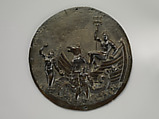Triumph of Neptune
Manner of Alvise of Padua
This roundel shows a beardless Neptune seated atop a vessel being pulled by a pair of hippocamps. Standing knee-deep in the sea’s undulating waves, a Triton holds the reins of one of the creatures, while a Nereid, holding an orblike object in her left hand, glances back. The relief is solid-cast, with an overall dark brown patina applied later in its history. The smooth outer edge is pierced with four holes and was likely originally covered by a frame.
The bronze was a favorite of the curator Yvonne Hackenbroch, who first published it in the 1962 catalogue of the Untermyer collection and in a standalone article in The Connoisseur magazine the same year. Placing it within the Venetian-Paduan orbit of the early sixteenth century, she noted the likely influence of Mantegna’s Battle of the Sea Gods, in particular a preparatory drawing of Tritons and hippocamps.[1] She named the artist the Master of the Triumph of Neptune and noted similarities in its format and punched ground to bronzes by the so-called Master of the Barbarigo Reliefs (see cat. 55).
The composition exists in at least four other known casts, including those in the Kress Collection, National Gallery of Art, Washington, D.C.; the Louvre (fig. 56a); the De Noailles collection; and a rectangular version in a private collection.[2] They exhibit slight variations. For example, the male figures in the Louvre relief have beards, and its background has a rayed effect. Though John Pope-Hennessy considered the Kress bronze superior to the present cast, James David Draper reversed this judgment, asserting its superiority over the Washington and Paris versions. Indeed, the smooth, assured modeling of the nude figures and the sensitivity of their expressions point to its refined production.
The bronzes were previously described as in the manner of a certain “Alvise of Padua,” who is mentioned in the Anonimo Morelliano as a collector and artist known for reliefs in the round.[3] This sculptor’s identity remains cloudy, and there are at least three goldsmiths with that name documented in Padua during this period.[4] The bronze can be more reasonably associated with the workshop of Antonio Lombardo in Venice during the second decade of the sixteenth century. The classicism of the figure types aligns closely with that of Antonio’s marble reliefs executed around 1508 for Alfonso I d’Este.[5] Neptune’s pose in the bronze follows that of the seated pointing figure at the right in Antonio’s Athena and Poseidon relief. Similarly, the raised hand of the Nereid echoes that of the figure to the left in the Forge of Vulcan relief, itself a quotation of the recently unearthed Laocoön. More formal and iconographic concordances can be seen between the Neptune bronze and Antonio’s Triumph of Hercules marble relief for Ferrara, as well as the reliefs on the bronze flagpoles in San Marco, signed by Alessandro Leopardi but convincingly proposed to be based on models by Antonio.[6] It should be stressed that Neptune imagery was scarce during the early Renaissance, with no large-scale statues surviving from antiquity.[7] These bronzes, like Antico’s Triumph of Neptune relief on his urn for Gianfrancesco Gonzaga (ca. 1487; Galleria Estense, Modena), are important early representations of the deity before his iconography became more standardized through writings like Vincenzo Cartari’s 1571 Le imagini de i dei de gli antichi.
As the god of the sea, Neptune was linked to Venice, which reinforces the likelihood of its place of origin for these bronzes. The city’s fortunes depended on its maritime activities, as illustrated in Jacopo de’ Barbari’s large-scale map of around 1500, in which a muscular Neptune surveys Venice from the water.[8] The relief’s compositional source is unknown, though it likely derives from ancient sarcophagi, intaglios, or coins, or the widely circulated niello prints that depict a similar scene (fig. 56b). While the subject of the bronze is traditionally described as a Triumph of Neptune, the god is shown without his wife Amphitrite at his side. She may be the Nereid at left in the scene, whose expression of horror and the object in her left hand, sometimes described as an apple, point to a specific as-yet-unidentified narrative.
-JF
Footnotes
(For key to shortened references see bibliography in Allen, Italian Renaissance and Baroque Bronzes in The Metropolitan Museum of Art. NY: The Metropolitan Museum of Art, 2022.)
1. Untermyer 1962, p. xvii, fig. 4.
2. NGA, 1957.14.429. For the De Noailles bronze (ex-Bischoffsheim collection), see Giraud 1881, pl. XX.
3. For the attribution, see ESDA/OF. For the goldsmith Alvise, see Michiel 1888, pp. 32–33; Motture 2008, p. 67.
4. Sartori 1976, pp. 247–48.
5. Now at the Hermitage, Н.CK-1770, 1771, 1773.
6. Wolters 1996; Ishii 2008, who provides an overview of hippocamps in works by Antico and Antonio Lombardo.
7. Freedman 1995.
8. A print is in the Minneapolis Institute of Art, 2010.88.
Due to rights restrictions, this image cannot be enlarged, viewed at full screen, or downloaded.

